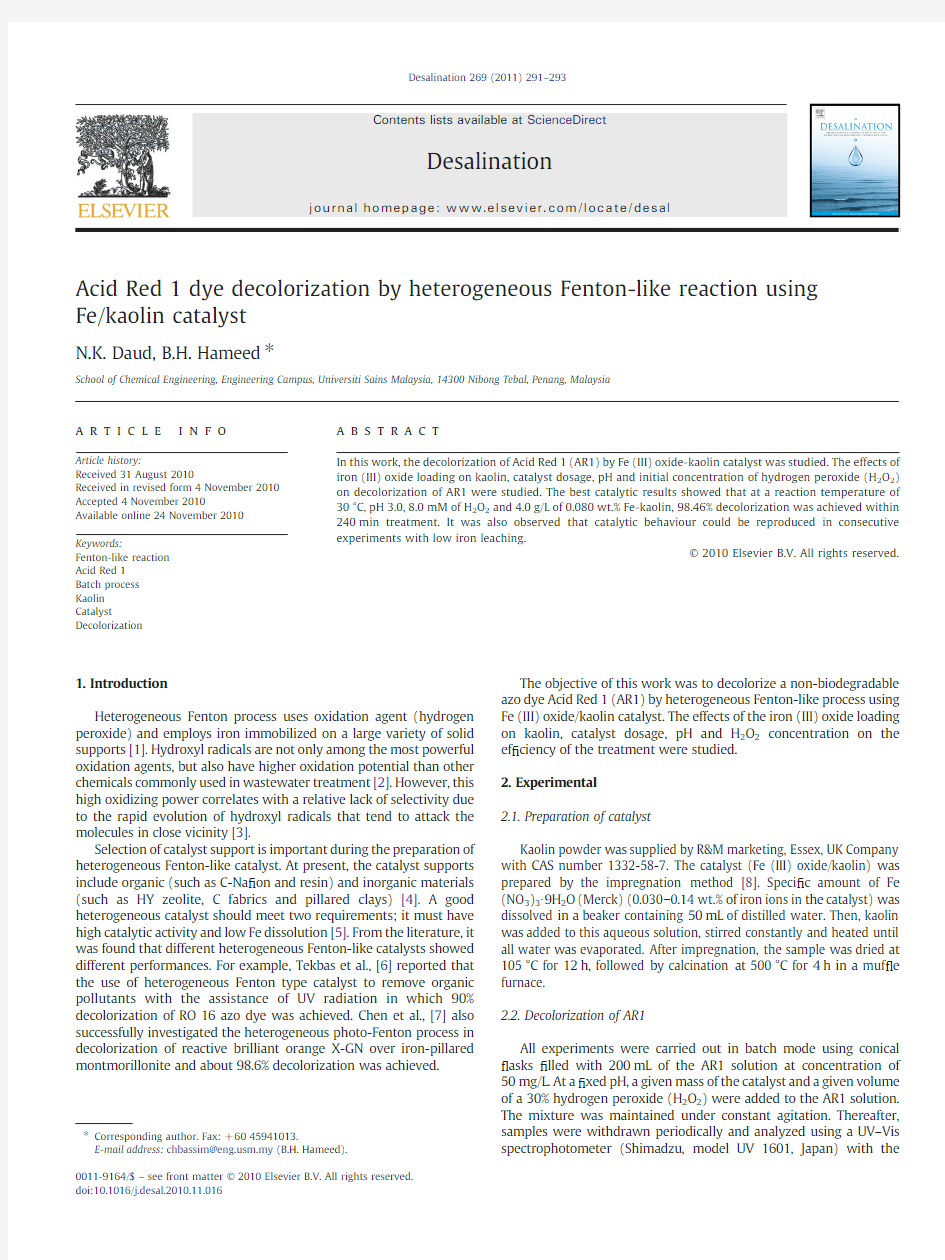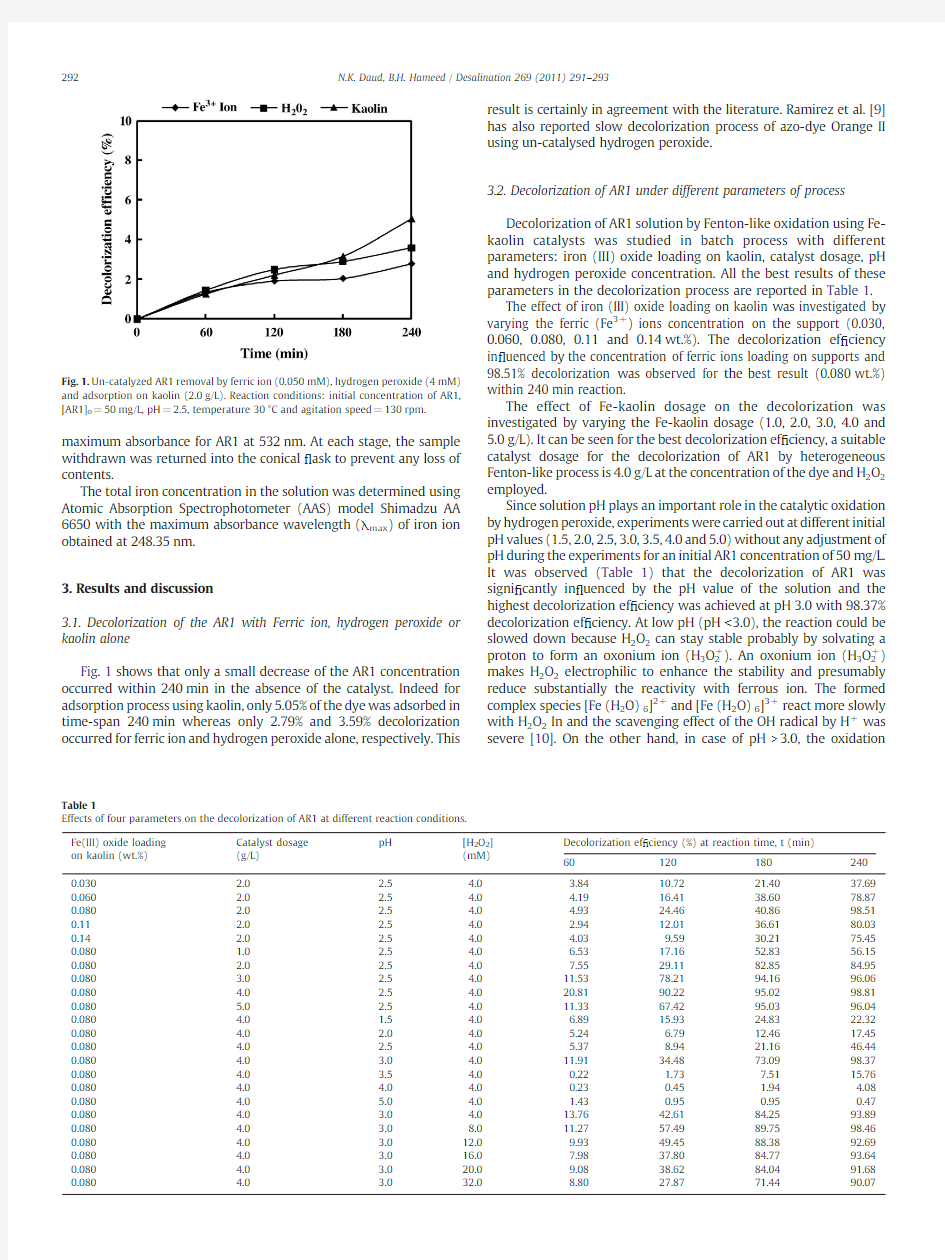Acid Red 1 dye decolorization__ by__ heterogeneous Fenton-like reaction using


Acid Red 1dye decolorization by heterogeneous Fenton-like reaction using Fe/kaolin catalyst
N.K.Daud,B.H.Hameed ?
School of Chemical Engineering,Engineering Campus,Universiti Sains Malaysia,14300Nibong Tebal,Penang,Malaysia
a b s t r a c t
a r t i c l e i n f o Article history:
Received 31August 2010
Received in revised form 4November 2010Accepted 4November 2010
Available online 24November 2010Keywords:
Fenton-like reaction Acid Red 1Batch process Kaolin Catalyst
Decolorization
In this work,the decolorization of Acid Red 1(AR1)by Fe (III)oxide-kaolin catalyst was studied.The effects of iron (III)oxide loading on kaolin,catalyst dosage,pH and initial concentration of hydrogen peroxide (H 2O 2)on decolorization of AR1were studied.The best catalytic results showed that at a reaction temperature of 30°C,pH 3.0,8.0mM of H 2O 2and 4.0g/L of 0.080wt.%Fe-kaolin,98.46%decolorization was achieved within 240min treatment.It was also observed that catalytic behaviour could be reproduced in consecutive experiments with low iron leaching.
?2010Elsevier B.V.All rights reserved.
1.Introduction
Heterogeneous Fenton process uses oxidation agent (hydrogen peroxide)and employs iron immobilized on a large variety of solid supports [1].Hydroxyl radicals are not only among the most powerful oxidation agents,but also have higher oxidation potential than other chemicals commonly used in wastewater treatment [2].However,this high oxidizing power correlates with a relative lack of selectivity due to the rapid evolution of hydroxyl radicals that tend to attack the molecules in close vicinity [3].
Selection of catalyst support is important during the preparation of heterogeneous Fenton-like catalyst.At present,the catalyst supports include organic (such as C-Na ?on and resin)and inorganic materials (such as HY zeolite,C fabrics and pillared clays)[4].A good heterogeneous catalyst should meet two requirements;it must have high catalytic activity and low Fe dissolution [5].From the literature,it was found that different heterogeneous Fenton-like catalysts showed different performances.For example,Tekbas et al.,[6]reported that the use of heterogeneous Fenton type catalyst to remove organic pollutants with the assistance of UV radiation in which 90%decolorization of RO 16azo dye was achieved.Chen et al.,[7]also successfully investigated the heterogeneous photo-Fenton process in decolorization of reactive brilliant orange X-GN over iron-pillared montmorillonite and about 98.6%decolorization was achieved.
The objective of this work was to decolorize a non-biodegradable azo dye Acid Red 1(AR1)by heterogeneous Fenton-like process using Fe (III)oxide/kaolin catalyst.The effects of the iron (III)oxide loading on kaolin,catalyst dosage,pH and H 2O 2concentration on the ef ?ciency of the treatment were studied.2.Experimental
2.1.Preparation of catalyst
Kaolin powder was supplied by R&M marketing,Essex,UK Company with CAS number 1332-58-7.The catalyst (Fe (III)oxide/kaolin)was prepared by the impregnation method [8].Speci ?c amount of Fe (NO 3)3?9H 2O (Merck)(0.030–0.14wt.%of iron ions in the catalyst)was dissolved in a beaker containing 50mL of distilled water.Then,kaolin was added to this aqueous solution,stirred constantly and heated until all water was evaporated.After impregnation,the sample was dried at 105°C for 12h,followed by calcination at 500°C for 4h in a muf ?e furnace.
2.2.Decolorization of AR1
All experiments were carried out in batch mode using conical ?asks ?lled with 200mL of the AR1solution at concentration of 50mg/L.At a ?xed pH,a given mass of the catalyst and a given volume of a 30%hydrogen peroxide (H 2O 2)were added to the AR1solution.The mixture was maintained under constant agitation.Thereafter,samples were withdrawn periodically and analyzed using a UV –Vis spectrophotometer (Shimadzu,model UV 1601,Japan)with the
Desalination 269(2011)291–293
?Corresponding author.Fax:+6045941013.
E-mail address:chbassim@https://www.360docs.net/doc/728945467.html,m.my (B.H.
Hameed).
0011-9164/$–see front matter ?2010Elsevier B.V.All rights reserved.doi:
10.1016/j.desal.2010.11.016
Contents lists available at ScienceDirect
Desalination
j o u r n a l h o me p a g e :w w w.e l sev i e r.c om /l oc a te /de sa l
maximum absorbance for AR1at 532nm.At each stage,the sample withdrawn was returned into the conical ?ask to prevent any loss of contents.
The total iron concentration in the solution was determined using Atomic Absorption Spectrophotometer (AAS)model Shimadzu AA 6650with the maximum absorbance wavelength (λmax )of iron ion obtained at 248.35nm.
3.Results and discussion
3.1.Decolorization of the AR1with Ferric ion,hydrogen peroxide or kaolin alone
Fig.1shows that only a small decrease of the AR1concentration occurred within 240min in the absence of the catalyst.Indeed for adsorption process using kaolin,only 5.05%of the dye was adsorbed in time-span 240min whereas only 2.79%and 3.59%decolorization occurred for ferric ion and hydrogen peroxide alone,respectively.This
result is certainly in agreement with the literature.Ramirez et al.[9]has also reported slow decolorization process of azo-dye Orange II using un-catalysed hydrogen peroxide.
3.2.Decolorization of AR1under different parameters of process Decolorization of AR1solution by Fenton-like oxidation using Fe-kaolin catalysts was studied in batch process with different parameters:iron (III)oxide loading on kaolin,catalyst dosage,pH and hydrogen peroxide concentration.All the best results of these parameters in the decolorization process are reported in Table 1.
The effect of iron (III)oxide loading on kaolin was investigated by varying the ferric (Fe 3+)ions concentration on the support (0.030,0.060,0.080,0.11and 0.14wt.%).The decolorization ef ?ciency in ?uenced by the concentration of ferric ions loading on supports and 98.51%decolorization was observed for the best result (0.080wt.%)within 240min reaction.
The effect of Fe-kaolin dosage on the decolorization was investigated by varying the Fe-kaolin dosage (1.0,2.0,3.0,4.0and 5.0g/L).It can be seen for the best decolorization ef ?ciency,a suitable catalyst dosage for the decolorization of AR1by heterogeneous Fenton-like process is 4.0g/L at the concentration of the dye and H 2O 2employed.
Since solution pH plays an important role in the catalytic oxidation by hydrogen peroxide,experiments were carried out at different initial pH values (1.5,2.0,2.5,3.0,3.5,4.0and 5.0)without any adjustment of pH during the experiments for an initial AR1concentration of 50mg/L.It was observed (Table 1)that the decolorization of AR1was signi ?cantly in ?uenced by the pH value of the solution and the highest decolorization ef ?ciency was achieved at pH 3.0with 98.37%decolorization ef ?ciency.At low pH (pH b 3.0),the reaction could be slowed down because H 2O 2can stay stable probably by solvating a
proton to form an oxonium ion (H 3O 2+).An oxonium ion (H 3O 2+
)makes H 2O 2electrophilic to enhance the stability and presumably reduce substantially the reactivity with ferrous ion.The formed complex species [Fe (H 2O)6]2+and [Fe (H 2O)6]3+react more slowly with H 2O 2In and the scavenging effect of the OH radical by H +was severe [10].On the other hand,in case of pH N 3.0,the
oxidation
Fig.1.Un-catalyzed AR1removal by ferric ion (0.050mM),hydrogen peroxide (4mM)and adsorption on kaolin (2.0g/L).Reaction conditions:initial concentration of AR1,[AR1]o =50mg/L,pH =2.5,temperature 30°C and agitation speed =130rpm.
Table 1
Effects of four parameters on the decolorization of AR1at different reaction conditions.Fe(III)oxide loading on kaolin (wt.%)Catalyst dosage (g/L)pH
[H 2O 2](mM)Decolorization ef ?ciency (%)at reaction time,t (min)601201802400.030 2.0 2.5 4.0 3.8410.7221.4037.690.060 2.0 2.5 4.0 4.1916.4138.6078.870.080 2.0 2.5 4.0 4.9324.4640.8698.510.11 2.0 2.5 4.0 2.9412.0136.6180.030.14 2.0 2.5 4.0 4.039.5930.2175.450.080 1.0 2.5 4.0 6.5317.1652.8356.150.080 2.0 2.5 4.07.5529.1182.8584.950.080 3.0 2.5 4.011.5378.2194.1696.060.080 4.0 2.5 4.020.8190.2295.0298.810.080 5.0 2.5 4.011.3367.4295.0396.040.080 4.0 1.5 4.0 6.8915.9324.8322.320.080 4.0 2.0 4.0 5.24 6.7912.4617.450.080 4.0 2.5 4.0 5.378.9421.1646.440.080 4.0 3.0 4.011.9134.4873.0998.370.080 4.0 3.5 4.00.22 1.737.5115.760.080 4.0 4.0 4.00.230.45 1.94 4.080.080 4.0 5.0 4.0 1.430.950.950.470.080 4.0 3.0 4.013.7642.6184.2593.890.080 4.0 3.08.011.2757.4989.7598.460.080 4.0 3.012.09.9349.4588.3892.690.080 4.0 3.016.07.9837.8084.7793.640.080 4.0 3.020.09.0838.6284.0491.680.080
4.0
3.0
32.0
8.80
27.87
71.44
90.07
292N.K.Daud,B.H.Hameed /Desalination 269(2011)291–293
ef ?ciency rapidly decreased,not only by decomposition of H 2O 2but also by deactivation of a ferrous catalyst with the formation of ferric hydroxide complexes leading to a reduction of ?OH radical [11].
The in ?uence of different concentrations of H 2O 2on the decolor-izing of AR1in the heterogeneous Fenton-like process was investi-gated from 4.0,8.0,12,16,20and 32mM.The enhancement of decolorization rate by addition of H 2O 2was due to increase in ?OH radicals.However,it should be pointed out that when the concentra-tion of H 2O 2was over 8.0mM,the removal of AR1decreased slightly.This can be explained by the scavenging of OH radicals at a higher concentration of H 2O 2,leading to decrease in the number of OH radicals in solution.Hence,a dosage of 8.0mM H 2O 2can be used as the optimum dosage for the decolorization of AR1.
The results of the effects of four parameters on the decolorization of AR1at different reaction conditions are listed in Table 1.Under the best reaction conditions,98.46%decolorization ef ?ciency was obtained within 240min at 4.0g/L of 0.080wt.%Fe-kaolin with 8.0mM of hydrogen peroxide in pH 3.0of AR1solution.3.3.The stability of Fe-kaolin catalyst
The stability of the Fe-kaolin catalyst was tested by contacting fresh AR1solutions with 4.0g/L of 0.080wt.%of Fe-kaolin catalyst from previous cycles for the decolorization of AR1under identical reaction conditions.This experiment was run in four consecutive cycles.As can be observed in Fig.2,98.46%decolorization ef ?ciency of AR1was achieved within 240min of reaction in the ?rst cycle.In the second,third and fourth cycles,92.78,35.66and 33.81%decoloriza-tion of AR1were achieved respectively.From the results,the reaction performances are signi ?cantly affected.This might be due to the loss of catalyst rather than active phase leaching.Other authors reported similar results,but they attributed the loss of activity to poisoning of the active catalytic sites due to adsorbed organic species [12].Catalyst deactivation may occur due to a diversity of factors including reduction of the catalyst speci ?c area,poisoning of the catalytic
agents by compounds formed during oxidation and surface deposition [13].Leaching tests were carried out to check the potential of leaching of iron ions from the catalysts after decolorization process of AR1completed.It was found that concentration of iron ion in the solution after reuse of the catalyst (0.080wt.%Fe-kaolin)for four consecutive cycles were 3.22,2.49,1.34and 0.45mg/L,respectively.4.Conclusions
The results revealed that under the best reaction conditions of a reaction temperature 30°C,pH 3.0,8.0mM H 2O 2,4.0g/L of 0.080wt.%Fe-kaolin catalyst,98.46%of AR1decolorization was achieved within 240min treatment.The experiments of stability showed that Fe-kaolin showed some activity decay after reuse for four consecutive cycles.This may be due to the loss of catalyst and active phase leaching during the experiments.Fe-kaolin catalyst exhibited good catalytic activity decolorization of AR1.Acknowledgement
The authors acknowledge the research grant provided by Universiti Sains Malaysia,under short-term grant that has resulted in this article.(Project No.6039004).The ?rst author also acknowledges the ?nancial support from National Science Fellowship (NSF),Ministry of Science,Technology and Innovation (MOSTI),Malaysia and Graduate Research-Research University Scheme (USM-RU-PRGS)(1001/PJKIMIA/8032040)provided by Universiti Sains Malaysia.References
[1]G.Ortiz de la Plata,O.Alfano,A.Cassano,Optical properties of goethite catalyst for
heterogeneous photo-Fenton https://www.360docs.net/doc/728945467.html,parison with a titanium dioxide catalyst,Chem.Eng.J.137(2008)396–410.
[2]R.Molina,F.Martinez,J.A.Melero,D.H.Bremner,A.G.Chakinada,Mineralization
of phenol by a heterogeneous ultrasound/Fe-SBA-15/H 2O 2process:multivariate study by factorial design of experiments,Appl.Catal.B 66(2006)198–207.
[3] C.W.Jones,Applications of Hydrogen Peroxide and Derivatives,The Royal Society
of Chemistry:Thomas Graham House,Science Park,Milton Road,2009.
[4]J.Chen,I.Zhu,Heterogeneous UV-Fenton catalytic degradation of dyestuff in
water with hydroxyl-Fe pillared bentonite,Catal.Today 126(2007)463–470.[5]Y.Zhang,X.Dou,J.Liu,M.Yang,L.Zhang,Y.Kamagata,Decolorization of reactive
brilliant red X-3B by heterogeneous photo-Fenton reaction using an Fe –Ce bimetal catalyst,Catal.Today 126(2007)387–393.
[6]M.Tekbas,H.C.Yatmaz,N.Bektas,Heterogeneous photo-Fenton oxidation of
reactive azo dye solutions using iron exchanged zeolite as a catalyst,Micropor.Mesopor.Mater.115(2008)594–602.
[7]Q.Chen,P.Wu,Y.Li,N.Zhu,Z.Dang,Heterogeneous photo-Fenton photo-degradation of reactive brilliant orange X-GN over iron pillared montmorillonite under visible irradiation,J.Hazard.Mater.168(2009)901–908.
[8]Y.Flores,R.Flores,A.A.Gallegos,Heterogeneous catalysis in the Fenton-type
system reactive black 5/H 2O 2,J.Mol.Catal.A Chem.281(2008)184–191.
[9]J.H.Ramirez,F.J.Maldonado-Hodar,A.F.Perez-Cadenas,C.Moreno-Castilla,C.A.
Costa,L.M.Madeira,Azo-dye Orange II degradation by heterogeneous Fenton-like reaction using carbon –Fe catalysts,Appl.Catal.B 75(2007)312–323.
[10]J.Feng,X.Hu,P.L.Yue,H.Y.Zhu,G.Q.Lu,Degradation of azo-dye orange II by a
photo-assisted Fenton reaction using a novel composted of iron oxide and silicate nano-particles as a catalyst,Ind.Eng.Chem.Res.42(2003)2058–2066.
[11]M.Muruganandham,M.Swaminathan,Decolorisation of reactive Orange 4by
Fenton and photo-Fenton oxidation technology,Dyes Pigm.63(2004)315–321.[12] C.Catrinescu,C.Teodosiu,M.Macoveanu,J.M.Brendle,R.L.Dred,Catalytic wet
peroxide oxidation of phenol over Fe-exchanged pillared beidellite,Water Res.37(2003)1154–1160.
[13]J.Guo,M.Al-Dahhan,Activity and stability of iron-containing pillared clay
catalysts for wet air oxidation of phenol,Appl.Catal.A 299(2006)175–
184.
Fig.2.Reusability test of the Fe-kaolin.Reaction conditions:initial concentration of AR1,[AR1]o =50mg/L,initial concentration of hydrogen peroxide,[H 2O 2]o =8.0mM,dosage of catalyst =4.0g/L with 0.080wt.%of iron ions in catalyst,agitation speed =130rpm,temperature=30°C and pH=3.0.
293
N.K.Daud,B.H.Hameed /Desalination 269(2011)291–293
